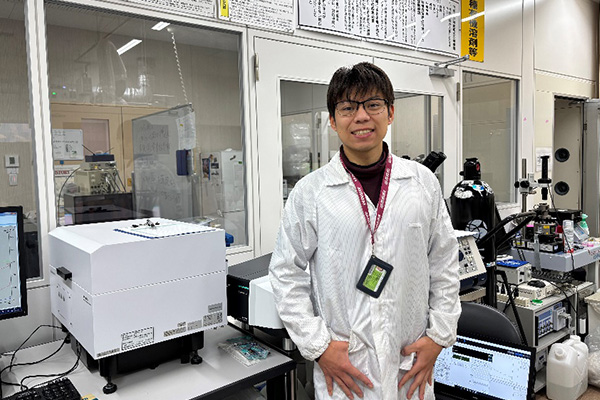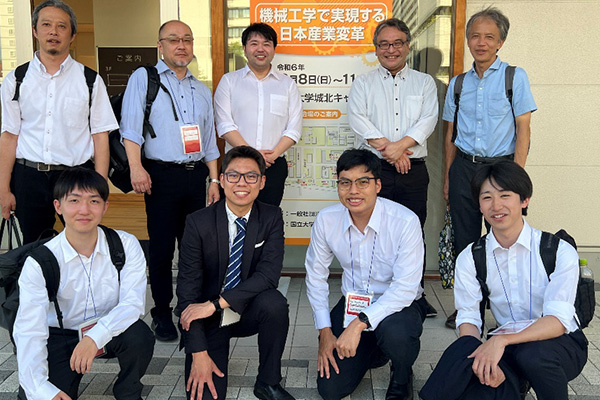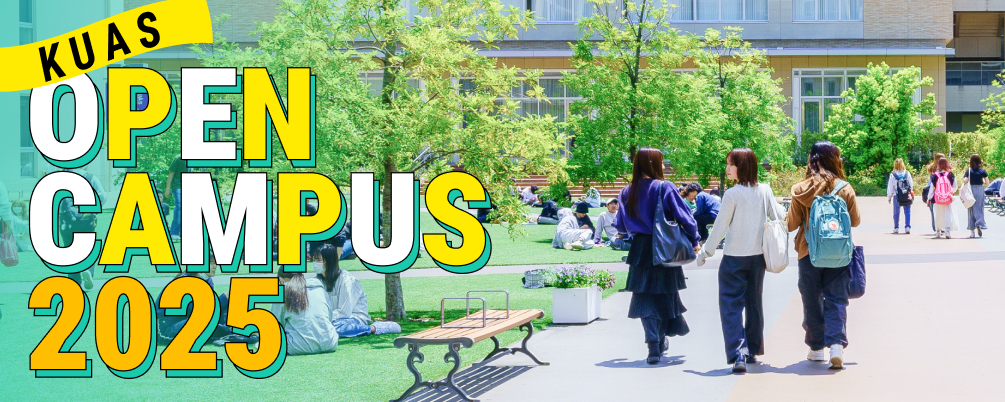本学大学院工学研究科修士2年生のDaniel Saldivar Ayala(ダニエル・サルディバル・アヤラ)さんと工学部の生津資大教授が、「Mechano-chromic behavior of liquid photonic crystals(液体フォトニック結晶のメカノクロミック挙動)」に関する研究発表で、日本機械学会マイクロ・ナノ工学部門優秀講演論文表彰を受賞しました。これは、マイクロ・ナノ工学部門主催の講演会および年次大会における発表の中から、特に研究内容が優れている論文の著者全員を表彰するもので、2024年9月に愛媛大学で開催された同学会年次大会での発表内容が評価され、今回の受賞となりました。
本学工学部の生津資大教授(専門分野:ナノメカニクス、ナノテクノロジ、機能性材料)の指導のもと、Danielさんは、シリカナノ粒子を用いた構造色の研究を行っています。構造色はモルフォ蝶やカメレオンの発色原理として知られており、光の波長程度で周期的に並ぶナノ構造体を変形させることで、その物体自体は色がないにもかかわらず発色する現象です。直径200nm程度のシリカナノ粒子を2枚のガラス板の間に面心立方構造になるように配列させ、外部から力学負荷を与えることで生じるガラス表面の変形分布を構造色の分布として表現することに成功しました。この技術を応用すれば、目に見えない極微小な変形を色の変化として捉えることができ、建造物の変形や劣化を可視化できる可能性があります。
Danielさんは、「私たちの研究成果が日本機械学会に認められてとても光栄です。新しい研究への挑戦は困難の連続でしたが、頑張ってきて良かったです。これからも頑張ります」と喜びを語っていました。生津教授は「今回の受賞はひとえにDaniel君の努力の賜物です。日頃から研究に励む優秀な学生が評価されて嬉しいです」と賛辞を述べました。


(前列左から2人目がDaniel君,後列右から2番目が生津教授)
(工学部教授 川上浩司)
Daniel Saldivar Ayala and Takahiro Namazu received the JSME Best Presentation Paper Award
Daniel Saldivar Ayala, a second-year master’s course student at the Graduate School of Engineering, and Takahiro Namazu, a Professor at the Faculty of Engineering, have received the Best Presentation Paper Award from the Micro-Nano Science & Engineering Division of the Japan Society of Mechanical Engineers (JSME) for their presentation entitled “Mechano-chromic behavior of liquid photonic crystals” This award recognizes all co-authors listed on papers with outstanding research topics and achievements among those presented at conferences and symposia organized by the JSME Micro-Nano Science & Engineering Division. Following a presentation at the 2024 JSME Annual Meeting their research achievements were very positively evaluated which culminated in their award.
Under Professor Takahiro Namazu’s supervision, Daniel is researching structural color using silica nanoparticles. Structural color is known as the coloring principle of morpho butterflies and chameleons, which is a phenomenon in which objects that are uncolored themselves can be colored by deforming nanostructures that are periodically arranged at approximately the wavelength of light. He manufactured a glass chip sensor containing silica nanoparticles with a diameter of approximately 200 nm arranged in a face-centered cubic structure. He succeeded in expressing the out-of-plane deformation of the glass surface caused by applying external mechanical load as a distribution of structural color. By applying this technology, it may be possible to detect extremely small deformations that are invisible to our naked eyes as changes in color, making it possible to visualize deformation and deterioration of buildings.
Daniel said, “It is a great honor for our research results to be recognized by the Japan Society of Mechanical Engineers. It was difficult for us to pursue new research, but now we feel proud to have worked so hard”. Professor Namazu added, “This award is solely the result of the great efforts of Daniel. I am so happy that our excellent students like Daniel, who work diligently on their research activities every day, have been recognized”.




